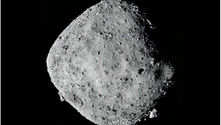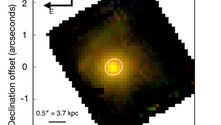top of page
News


Astronomers Identify Potential First Generation Stars in Distant Galaxy
For years, astronomers have hunted for Population III (Pop III) stars. These are the first stars ever born, composed *only* of the hydrogen and helium left over from the Big Bang. They were massive, lived short, violent lives, and died out long ago. Now, a team led by Ari Visbal believes they've spotted their signature in a distant galaxy called LAP1-B, and it's the first candidate to match all theoretical predictions.
Nov 51 min read


New observations from the James Webb Space Telescope peer into one of the Milky Way's most active and extreme star-forming clouds
Sagittarius B2 (Sgr B2) is a titan of star formation, a dense cloud near our galactic center churning out new stars at a furious pace. Using the unprecedented power of the James Webb Space Telescope's infrared eyes, astronomers have pierced through the obscuring dust to get their clearest view yet of this stellar nursery, revealing hidden structures and challenging previous assumptions about how stars form in extreme environments.
Sep 231 min read


Samples returned from Asteroid Bennu reveal a time capsule containing ingredients from before our solar system was even born
The OSIRIS-REx mission has successfully brought back pieces of the near-Earth asteroid Bennu, and the findings are extraordinary. More than just a simple space rock, Bennu is a composite object, assembled from the rubble of a much larger parent body. Its chemistry tells a story of materials gathered from the hot inner solar system, the icy outer reaches, and even from ancient stars that died long before our sun ignited.
Aug 281 min read


CHORD: The Ambitious Canadian Project Set to Change Astronomy
Building on the wild success of its predecessor, CHIME, the Canadian Hydrogen Observatory and Radio-transient Detector (CHORD) will be an order of magnitude more powerful. This homegrown telescope will leverage cutting-edge technology to detect thousands of Fast Radio Bursts (FRBs) in real-time, giving astronomers an unprecedented tool to map the cosmos and understand the enigmatic sources of these fleeting, powerful signals.
Aug 281 min read


NASA's Perseverance Rover Explores New Terrain at Soroya Ridge
After a mini-campaign studying wind-formed features at a location named Parnasset, Perseverance executed three successful drives to arrive at Soroya. This striking landform was first identified from orbit due to its bright appearance against the darker Martian terrain. Now on the ground, the science team is deploying the rover's full suite of instruments to analyze its composition and texture, seeking clues about Mars's ancient past.
Aug 281 min read


Mars's Mantle Reveals Ancient Secrets of Planetary Chaos
Textbook illustrations often depict rocky planets with neat, uniform layers: a crust, mantle, and core. But for Mars, the reality is far messier. Seismic data from NASA's InSight lander has uncovered a chunky interior, where fragments from colossal, planet-forming impacts are still preserved like geological fossils, giving us a unique glimpse into the chaotic first 100 million years of the solar system.
Aug 281 min read


How TESS and Kepler Help Map Star Spots Across the Galaxy
When hunting for other worlds, astronomers have a problem: the stars those planets orbit are not perfect, uniform spheres of light. Like our own sun, they are complex, active, and covered in dark "star spots." A new method, `StarryStarryProcess`, uses the transits of exoplanets to map these spots, helping scientists untangle the light of the star from the light of the planet.
Aug 261 min read


How Steam Worlds Challenge Our Views on Planetary Habitability
In the search for life, astrobiologists follow the water. It turns out the most common type of exoplanet, the "sub-Neptune," is likely water-rich. But there's a catch. Orbiting far closer to their stars than Earth, these worlds are too hot for liquid oceans. Instead, they are "steam worlds," with thick, steamy atmospheres over bizarre, high-pressure phases of water. Now, researchers at UC Santa Cruz have developed a new model to finally understand the anatomy of these exotic
Aug 261 min read


Astronomers Discover Ancient Galaxy with Unusual Slow Rotation
In the local universe, the most massive galaxies are "slow-rotators"—giant, evolved systems supported by the random, chaotic motion of their stars rather than orderly rotation. They are the "retired" galaxies of the cosmos, having stopped forming stars long ago. Finding such a galaxy in the *early* universe (at high redshift) is rare.
Aug 261 min read


Astronomers Identify New X-ray Beacons in Distant Galaxy NGC 5813
Ultraluminous X-ray Sources (ULXs) are point-like sources that are bafflingly bright—emitting more X-ray radiation than one million suns combined. Their true nature is elusive, as they are too bright to be normal stellar-mass black holes, but not at the center of galaxies like supermassive black holes. The leading theories suggest they are powered by either stellar-mass black holes feeding at an extreme rate, or by highly magnetized neutron stars (pulsars).
Aug 161 min read


A Stellar Death: How SN 2023zkd Redefined Supernovae
Astronomers have discovered what may be a massive star exploding *while trying to swallow* a black hole, offering an explanation for one of the strangest stellar explosions ever seen. The blast, named SN 2023zkd, was first flagged in July 2023 by a new AI algorithm. This early alert allowed scientists to observe the event in real-time, revealing a multi-year story that challenges our understanding of how stars die.
Aug 161 min read


New Discoveries in Space: Mice Born from Frozen Cells in Orbit
Spaceflight takes a toll on the body, from muscle wasting to bone density loss. But what about the cells responsible for the next generation? Studying the impact on germ cells (sperm and egg precursors) is critical, as any damage could be passed to offspring. Inspired by previous studies showing abnormalities in stem cells flown to space, a team at Kyoto University designed an experiment to test the resilience of spermatogonial stem cells (SSCs).
Aug 161 min read
bottom of page


